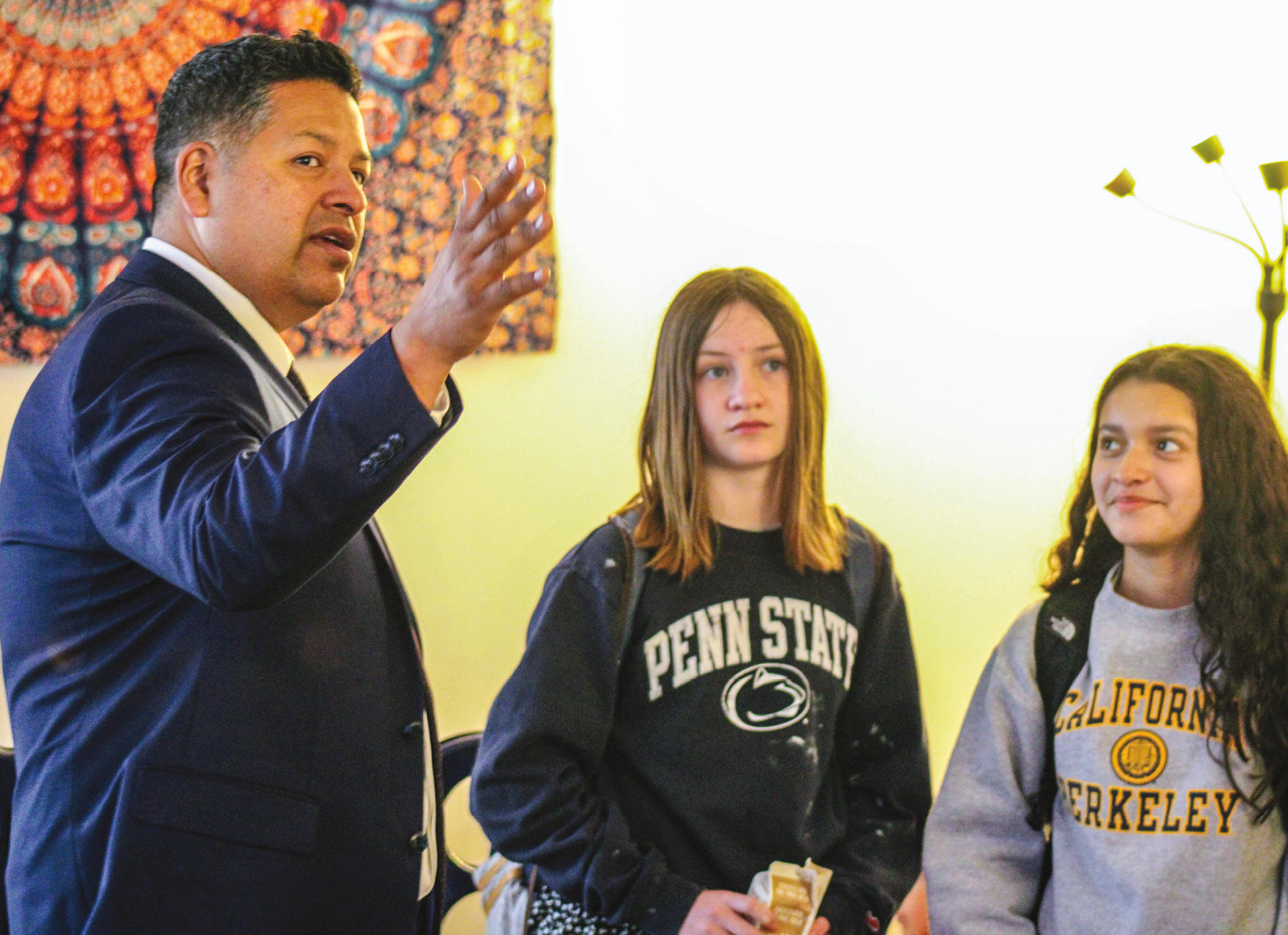A Mindshift Over Cellphones in Schools
June 01, 2024
Appears in June 2024: School Administrator.
School district experiences document the strategical path to make classrooms phone-free places once again

Principals often note that their teachers perform best when they engage and inspire. They craft lessons that motivate and stimulate. Their interactive lessons and labs galvanize students to want to learn more.
Today’s teachers are working harder and harder just to get their students’ attention. The chief reason: Cellphones. A mindset shift is needed.
School district leaders across the country can relate to the swinging pendulum regarding cellphones. After the release of the iPhone in 2007 and the Android in 2008, schools quickly adopted policies prohibiting them. Within a few years, after seeing the value of allowing children to bring their personal devices to school, districts changed these practices and policies, stating that “all use of personal electronic devices during the school day shall be for appropriate educational purposes only.”
Almost immediately, schools were overrun by smartphones and social media, dominating the attention of teenagers and contributing to constant friction between children and teachers.
Escalating Distractions
In 2020, the global pandemic hit. When children returned to in-person learning, schools were unprepared for what they experienced. Across the globe, experts warned teachers and leaders about learning loss. Those fears were realized by many children who had been isolated from their teachers and their peers.
Christy Lobao, superintendent in Atwater, Calif., found the dynamic regarding personal devices dramatically altered during the post-COVID period.
“There were spikes in improper use of cellphones to capture video and engage in cyberbullying,” she says. “When we looked at the increased number of kids who owned a smartphone versus the trend of cyberbullying, we saw the increase go hand in hand.” The data called for a shift in thinking about phones.
Lobao examined her district’s end-of-year data on student discipline. “I wanted to know what it looked like. What did we really need to focus on? Where were the trends going?” she explains. “I noticed so many cellphone infractions that were serious, and I never want to have to sit in another meeting with a parent and say, ‘there’s a video of your child that I have no power to take down.’”
Across the country in Chicopee, Mass., Carol Kruser, the school district’s assistant superintendent for student support, was facing the same situation. A former high school principal, she made the decision with her school community to go phone-free because of the troubling conditions.
“When we came back from the pandemic, it wasn’t just an occasional text,” Kruser says. “It wasn’t just, ‘I’ll look at my phone really quickly.’ It was literally students who were watching Netflix and videos and just refusing to put the phone away. And we had some big fights, and these fights were recorded. Some of these things happened pre-pandemic, but afterwards it just notched it up to a whole new level.”
Standing Together
In “What’s Going on With Educator Shortages?,” AASA’s 2022 survey of school district leaders nationwide, 45 percent of respondents reported teacher burnout as the principal cause of the educator shortage. Noelle Gilzow, a high school science teacher in Columbia, Mo., and president of the teachers’ union in Columbia, points to cellphones as a major reason for teachers’ emotional burnout and departures. “They can’t compete,” she says.
Gilzow surveyed her local members, with 61 percent listing cellphones as the working-condition issue of greatest concern, even bigger than salary. “If we took the elementary schools out of the survey,” she says, “that percentage would be even higher.” Teachers want a solution.
Lobao, whose elementary school district in California enrolls nearly 5,000 students, agrees, even though she’s dealing with younger students.
“For years,” she says, “we’ve been looking at how do we control this? Our district rule was [phones] are to stay off and away. Did they stay off and away? Administrators were called to classrooms to deal with discipline, a standoff with the teacher, which is not what we should be focused on during the school day.”
Some school administrators might think that pursuing a phone-free space would be an unwelcome decision. Kruser, in Chicopee, was no different, saying, “At the time, I’m going to be honest, I wasn’t sure if I was creating career suicide. No one was doing it around here.”

Going phone-free requires a fundamental shift in thinking, and it requires a coalition of supporters. Similar to adopting new reading instruction materials or a new start time to the school day, leaders who go it alone find themselves identified as the single point of failure. Kruser encourages leaders to host in-person student and parent forums on the subject to gain understanding and potential buy-in.
Diego Ochoa, superintendent of the San Mateo-Foster City School District in California, reached the point of action in 2022 when he authorized the purchase of Yondr pouches for use at all four middle schools. Yondr pouches are magnetically sealed fabric containers to lock up phones or other devices for safe keeping. The pouches are reusable and only slightly bigger than a smartphone. They lock and unlock with the touch of a specialized magnet.
Ochoa has only one regret: “I wish I had talked to my students more about the decision. … If we had done that, we could have avoided some of the trip ups we had when we implemented [phone-free schools].”
Weapons of Distraction
Drawing attention to persistent declines of U.S. students on international assessments and citing the research of psychologists Jonathan Haidt and Jean Twenge, the Atlantic in December 2023 reported an alarming relationship between cellphones and student achievement. The article showed how the decline in test scores on PISA, notably the international math assessment, were linked to obsessive cellphone use inside and outside of school equal to four times greater than pandemic learning loss.
In 2023, U.S. Surgeon General Vivek Murthey issued a “call for urgent action” to develop policies around students’ social media access. His findings showed an erosion in teen self-esteem and body image. State and federal legislatures and their agencies began working on ways to eliminate emotionally damaging content.
One strategy was to create phone-free schools. At the beginning of the 2023-24 school year, Florida’s legislature passed restrictions on cellphone possession at school. In Massachusetts, the state education agency issued guidance and made funds available for schools to become phone-free. Oklahoma, Vermont, Kansas and Missouri have introduced phone-free legislation, and the governors of Connecticut and Utah have formally encouraged action.
While some of the superintendents I interviewed made this decision themselves, others indicated that legislative action would provide them and their school boards with political cover. Not everyone agrees. A state superintendents association in the Midwest polled its executive committee, which cautioned against unfunded mandates and endorsed maintaining local control on cellphone practices.

Positive Developments
When schools in Philadelphia made the decision in 2018 to go phone-free, the implementation yielded encouraging results, including positive social interaction among students. In fall 2022, the district invested in a pouch system for cellphones at 52 schools. Students who had been addicted to an online community of strangers now talk to their peers and socialize with them more in group activities.
In California, two school districts saw something similar. In Atwater, Lobao says her school district first piloted a phone-free policy with their 5th through 8th graders at two schools. The impact was noticeable. With a bright smile, she reports, “Before we went phone-free, students were just silently scrolling, and now kids actually started playing during recess. It’s so fun to watch them play basketball and not to be huddled around each other trying to sneak a look on a phone. I love it.”
Further, she says the counselors and aides she had hired to build relationships with children took on more significant roles. They no longer were policing cellphones. Ochoa observed a difference in student interaction in the classrooms of the San Mateo-Foster City School District. “They’re talking to each other. They’re learning from each other,” he says. “The teacher is the activator.”
A Community Shift
The first thing that comes to mind when school leaders are considering a significant change is what proponents and opponents say about the proposed change — in this case regulating student behavior around cellphone use. When it comes to going phone-free, safety and security are the top concerns.
Kruser notes that local law enforcement in her western Massachusetts community supports going phone-free in schools because the devices cause more confusion than they help during critical situations. In times of an emergency or perceived crisis, she says, “people give misinformation. Everyone runs to the building.”
Melissa Randol, executive director of the Missouri School Boards Association, which runs a Center for Educational Safety, concurs on the public safety issue. “Cell towers become overwhelmed, and first responders can’t do their job,” she says.
Technology’s Place
There is no question that schools have a responsibility to prepare children for an ever-changing world. We know for sure that technology will continue to be a significant aspect of their lives. Appropriate technology use can be achieved in a phone-free space.
“There are many things I can do with the current technology,” Lobao says. “Nearly all schools went 1:1 during the pandemic. I can teach them to be completely tech savvy. That does not require a device in their hand. Just because we have a phone does not mean it’s appropriate for all situations. And it’s not.” n
Peter Stiepleman, a former superintendent, is an educational consultant in Bainbridge Island, Wash. He maintains a podcast, An Imperfect Leader.
Author
Considerations for Moving to Phone-Free Schools
In preparing this article, each school district leader I consulted compared implementing a phone-free school program to that of adopting a major schoolwide change.
They noted that school districts that make major changes, such as adjusting the bell schedule, adopting new curricular materials or modifying the school day’s start time, understand that high levels of collaboration are important and harvesting the collective wisdom of both internal and external audiences is essential.
Based on their experiences, here are a few suggestions when making the shift to minimize the distractions of cellphones.
Stakeholder feedback. Start by gathering input from students, parents/guardians, teachers and school administrators through surveys and advisory groups. This feedback will reflect many of your community’s sentiments and ensure diverse perspectives are considered. Additionally, by engaging stakeholders early in the process, you create commitment and alignment with the school’s or district’s strategic plan.
Provide context for the board. To provide external validation and context for decision making, in your communication with school board members, share reliable information on the subject from sources that don’t hold a conflict of interest. Articles from reputable sources offer diverse perspectives. They can help explain the rationale behind proposed policy changes and allow board members to discover what others have learned from their moves to phone-free environments.
Board meeting presentation. Present survey findings and advisory input to the school board as part of the superintendent’s report or as a non-action item on the agenda. This facilitates public dialogue and transparency by the board, helping the community understand the rationale well before final decisions are made. This presentation demonstrates a commitment to inclusive decision-making processes and a responsiveness to community needs.
Involvement of local authorities. Seek feedback from key figures in the community, such as the mayor, city or town council, police chief and first responders, on how phone use during school-based incidents might lead to confusion and misinformation or impact emergency response efforts.
Clarify how restricting phone use can facilitate effective communication and emergency management. By emphasizing this aspect of a phone-free environment, school leaders show that they prioritize student safety and community well-being.
Parent information sharing. Host an in-person parent information night to discuss the proposed phone-free school program. Consider using a World Café-style format to encourage genuine dialogue among participants. Invite representatives of the teachers’ union and administrators to facilitate discussions and address concerns. Gather notes from the World Café and make those notes available to the school board and public.
Starting with pilots. Consider starting with a pilot program or two to test the effectiveness of the phone-free initiative. This allows for ongoing observations and stakeholder feedback, helping to refine policies before full-scale implementation across all schools in the district.
Ongoing parent feedback. Schools that adopt a phone-free program encourage parents to call the main office to communicate information to their children during the school day. Some also have established a dedicated e-mail account for parent-school communication or adjust their firewall settings to allow parents to e-mail their children at school. These measures improve accessibility and facilitate parental involvement in school-related matters.
Leadership and program fidelity. Strong leadership drives successful implementation and sustainability of the phone-free school program. District leaders need to emphasize to school leaders the importance of consistent adherence to policies to ensure the program’s effectiveness in improving the learning environment.
— Peter Stiepleman
Additional Resources
Author Peter Stiepleman recommends these informational resources relating to phone-free spaces in schools.
Atlantic article, “It Sure Looks Like Phones Are Making Students Dumber”
Centers for Disease Control and Prevention report on electronic bullying
Surgeon General’s advisory about effects of social media use on youth mental health
2023 UNESCO Global Education Monitoring Report, “A Tool on Whose Terms?”
Advertisement
Advertisement
Advertisement
Advertisement


